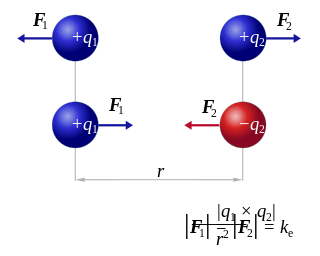Coulomb's law
a physical law that states the electric force between two point charges is proportional to the product of the charges and inversely proportional to the square of the distance between them. From Wikipedia, the free encyclopedia
Remove ads
Coulomb's law is a function developed in the 1780s by physicist Charles-Augustin de Coulomb. It explains how strong the force will be between two electrostatic charges. Electrostatic means electric charges without any motion.

Direction

Let's think of two electric charges existing in an empty space. If the two charges are opposite, (+) and (-) charges for example, they will attract each other. And if two charges are both the same, both (+) or both (-) for example, they will push each other. This is similar to how magnets act, as N and S attract each other, and as N and N, S and S push each other.
This is because electric charges make an electric field. If two fields exist in the same space at the same time, then the two fields exert (~ put) force on each other. The force they make on each other is called 'Coulomb's force' or the electrostatic force. Coulomb's law explains how big the force will be.
Remove ads
Scale
Coulomb's law explains the scale between two electric charges. The scale of electrostatic force follows the function below.
Coulomb's law explains that the force scale F is relative to ratio of ,.
and are the scales of each electric charge. is the distance between the two electric charges. And has a certain value. It does not change relative to , or . While remains constant, when multiples of and become bigger, the electrostatic force will also get bigger. When the distance becomes bigger, the electrostatic force will become smaller by the ratio of .
The exact size of is
N m2 C−2 (or m F−1). This constant is called Coulomb's force constant or the electrostatic force constant.
Remove ads
Inverse-square law
The relation between the force of pushing or pulling (F) and the distance between the particles () follows the Inverse-square Law. Inverse-square law means that when the distance grows bigger, the force gets weaker by the ratio . Gravitation, Electromagnetic radiation, and sound loudness also follow this law.
Related pages
- Magnetic
- Electrostatic
- Coulomb, the SI unit of electric charge named after Charles-Augustin de Coulomb
- Inverse-square law, the physical law that shows the relation between distance and Intensity.
Other websites
- Coulomb's Law on Project PHYSNET.
- A maze game for teaching Coulomb's Law Archived 2009-05-05 at the Wayback Machine
Wikiwand - on
Seamless Wikipedia browsing. On steroids.
Remove ads










